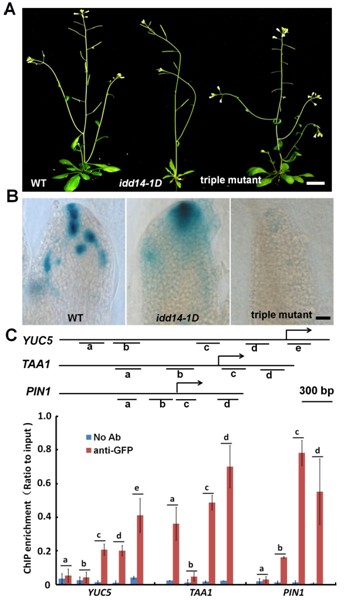Auxin is a key plant hormone and its spatial accumulation is essential for lateral organ morphogenesis, gravitropic responses and other developmental processes in higher plants. However, the various mechanisms through which spatial auxin accumulation is regulated remain to be fully elucidated. In the newly published paper, Dr. Yuxin Hu’s Group reported that the plant-specific transcription factors IDD14, IDD15, and IDD16 redundantly and cooperatively regulate leaf shape, flower development, fertility, plant architecture, and gravitropic responses. Further studies demonstrated these IDD transcription factors influence the spatial accumulation of auxin by directly targeting auxin biosynthetic and transport genes to activate their expression, thereby controlling organ development and gravitropic responses. These findings provide a new insight into the molecular mechanism underlying the regulation of spatial auxin gradients and organ morphogenesis in plants.
This work has been published in PLoS Genetics (Cui et al., 2013, doi:10.1371/journal.pgen.1003759). The work was supported by grants from the Ministry of Science and Technology of China and the National Natural Science Foundation of China.

IDD transcription factors regulate Arabidopsis organ development and auxin spatial accumulation
(A) Phenotypes of gain-of-function idd14-1D and loss-of-function idd mutants.
(B) Auxin spatial accumulation in the leaves of WT, idd14-1D, and idd triple mutant plants.
(C) IDD14 directly binds to the DNA region of YUC5, TAA1, and PIN1.
Auxin is a key plant hormone and its spatial accumulation is essential for lateral organ morphogenesis, gravitropic responses and other developmental processes in higher plants. However, the various mechanisms through which spatial auxin accumulation is regulated remain to be fully elucidated. In the newly published paper, Dr. Yuxin Hu’s Group reported that the plant-specific transcription factors IDD14, IDD15, and IDD16 redundantly and cooperatively regulate leaf shape, flower development, fertility, plant architecture, and gravitropic responses. Further studies demonstrated these IDD transcription factors influence the spatial accumulation of auxin by directly targeting auxin biosynthetic and transport genes to activate their expression, thereby controlling organ development and gravitropic responses. These findings provide a new insight into the molecular mechanism underlying the regulation of spatial auxin gradients and organ morphogenesis in plants.
This work has been published in PLoS Genetics (Cui et al., 2013, doi:10.1371/journal.pgen.1003759). The work was supported by grants from the Ministry of Science and Technology of China and the National Natural Science Foundation of China.

IDD transcription factors regulate Arabidopsis organ development and auxin spatial accumulation
(A) Phenotypes of gain-of-function idd14-1D and loss-of-function idd mutants.
(B) Auxin spatial accumulation in the leaves of WT, idd14-1D, and idd triple mutant plants.
(C) IDD14 directly binds to the DNA region of YUC5, TAA1, and PIN1.
